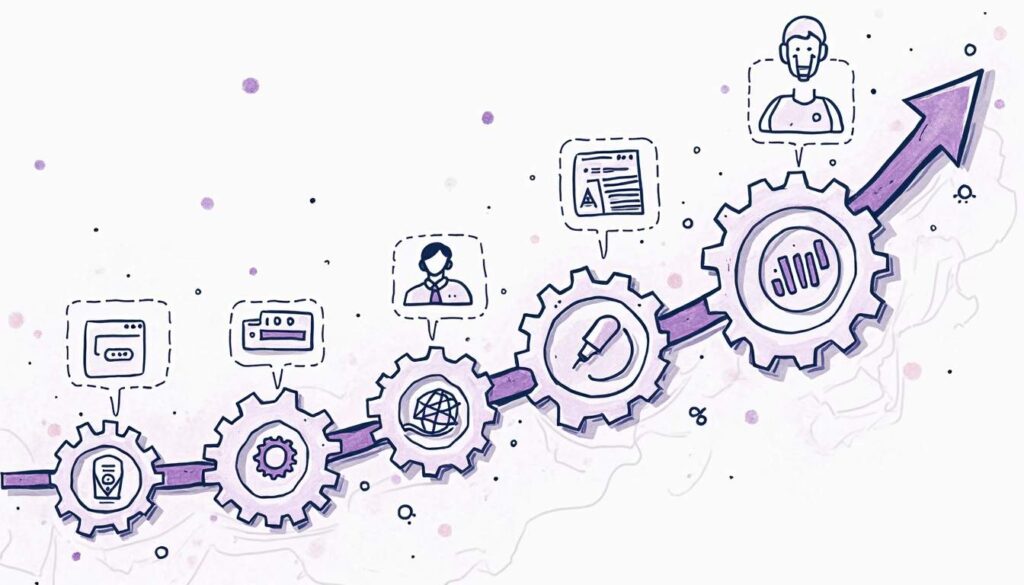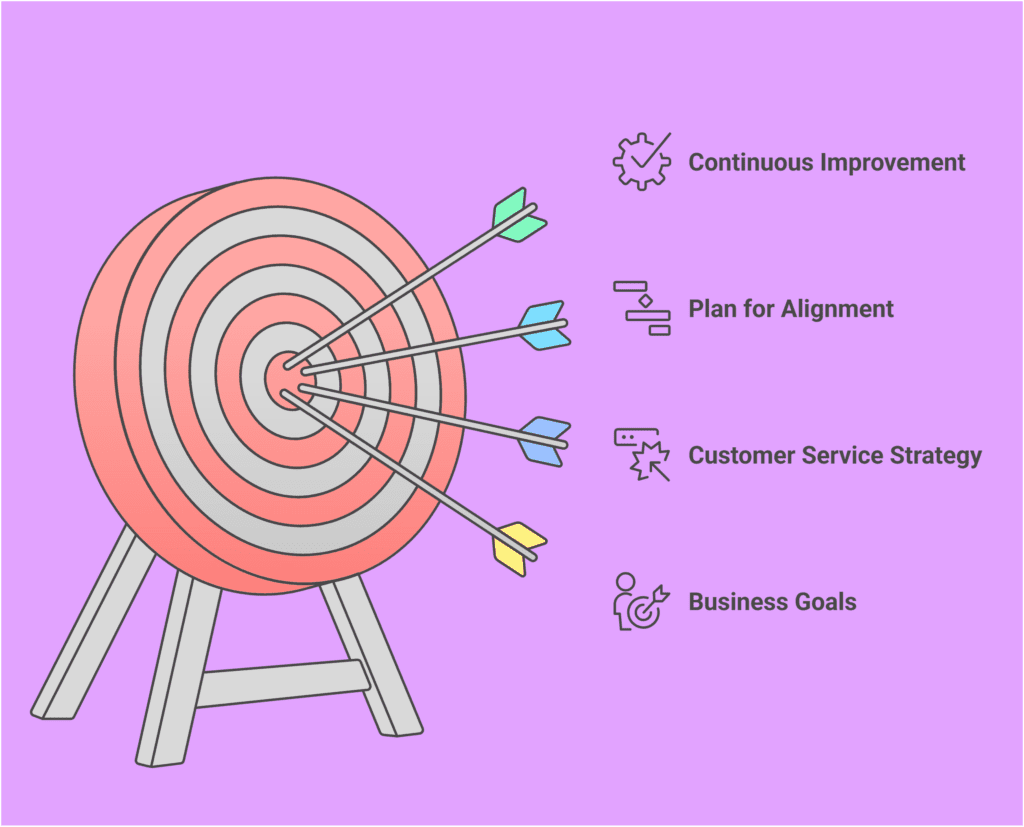How to Align Your Customer Service Management Strategy with High-Value Business Goals
12 Feb 2025 By: Maria Rush
Updated
It is very important to revise your customer service management strategy to conform to your overall business objectives in order to realize great customer success. This paper will walk you through its significance, process to do so and the most important aspects of the strategy.

Understanding the Importance of Alignment in Business Strategy
The strategy of managing your customer service ought to be aligned to your business objectives in order to grow. It is a guarantee that all the customer contact is company goal oriented, which leads to success.
The Role of Customer Service in Business Success
Customer service helps in creating the image of a company, and forms loyalty. Repeat business and referral will be a result of positive interaction whereas poor service will be detrimental to the reputation. According to a study conducted by HubSpot, 93 percent of customers are willing to repurchase the companies that provide the best customer service.
In addition to satisfaction, customer service provides customer information that is used in product development, marketing, and engagement. This can be facilitated by a well-managed knowledge base management system that centralizes the insights and provides the teams to take action based on customer feedback. Those businesses that interpret feedback are able to adjust to trend and enhance experiences which promotes growth.
The Connection Between Business Goals and Customer Service Management
Business goals determine the path a company takes. By synchronizing customer service management strategy with these goals, a smooth process is created which positively impacts customer experience. Salesforce research indicated that 89% of consumers tend to repurchase more if the customer service was good.
One such case is when a company plans to increase its hold on the market, then its support-related strategy should be obtaining and keeping clients through the provision of excellent service.
The result of this will be increased satisfaction, improved customer relationships, and reduced customer movement away from the business. In addition, it will make the employees feel good since they will understand their roles within the company’s vision. Just increasing customer retention rates by 5% will bring a profit increase of 25% to even 95%.
A motivated and skillful staff doing the same as the company in terms of objectives will help a lot in making the customer’s experience superb. This kind of situation creates a win-win situation where both customers and the company reap the advantages.
Trending Now: The Evolution of Digital Business Strategy Service Providers
As digital business leaders focus on value creation, service providers must adapt to meet higher expectations. The conventional models of sales and delivery have become obsolete. The clients nowadays want measurable financial outcomes, strategic accountability, and a long-term impact.
The adoption of value-based pricing is taking over the time-and-material models, putting the service providers in a situation where they need to prove their worth. The taking of digital projects as business-related has made them more significant. It is also important to get around the difficult stakeholder settings since digital budgets involve C-level executives and different business units. In order not to lose their place in the market, service providers have to change their tactics and at the same time render a great deal of their estate.
Steps to Align Your Customer Service Management Strategy with Business Goals

Strategically aligning the service department with the business goals is an extensive customer service alignment. An effective customer service alignment, following these steps can be used as a guide to creating a clear roadmap.
Identifying Your Business Goals
The first step is to clearly define business goals. These can including, but not limited to, increase in sales, bettering customer experience, exploring new geographical markets, and more efficient labor. One can use the SMART criteria during the whole process meaning that the objectives will be clearly defined, quantitatively assessed, realistically attained, significant, and time-bound. Helps set a solid foundation for alignment.
The involvement of the most interested parties will guarantee that the customer service department plays a major role in achieving those goals. This can be achieved by running workshops, brainstorming, and having team-building activities that will not only help in cooperating but also make the sense of ownership. In addition, the input from the frontline employees will be extremely valuable in getting to know the customer wants and problems, thus making the business goals more customer-oriented and feasible. Salesforce statistics showed that 86% of agents and 74% of mobile workers say customer expectations are higher than they used to be.
Defining Your Customer Service Management Strategy
Once you have set business goals, the next thing you need to do is come up with a customer service management strategy which will involve interaction protocols, service expectations, support methods, etc.
The practice management software does not only increase the efficiency of the practice but also the satisfaction of the customers by simplifying and speeding up the major processes like scheduling, patient management, and reporting. The practice management solutions which are equipped with user-friendly interfaces and smooth connection to the existing systems give the companies the power to present the excellent service that is in line with the general business strategies.
Your goals should dictate your strategy. Among the main questions that you should ask yourself are: What are the customers’ demands that your strategy will satisfy? What will be the service channels? What is the function of training in reaching these goals?
To ensure that the strategy is clear and consistent all over the organization, document it. The use of technology like CRM systems can facilitate the process by providing insights that improve decision-making and service delivery thus enhancing efficiency.
Creating a Plan for Alignment
Your last move is to prepare an extensive plan that relates customer service actions to the company’s goals. The plan should include the duration, responsible people, and specific activities to be done.
Setting customer service goals alongside the performance metrics is a guarantee of alignment. In sectors where compliance matters, knowing the UBO meaning can guide how customer data and onboarding are handled. For instance, customer satisfaction linked to retention goals would imply that the service quality is good.
Periodic reviews of the metrics and realignment of the strategies will be a way of keeping the alignment dynamic. A culture of continuous improvement will encourage innovation which in turn produces better business outcomes.
Key Components of an Aligned Strategy
A customer service strategy’s success hinges on prioritization of the key components. The elements form a robust structure that underpins alignment and consummate service.
Communication and Collaboration
The very best communication and cooperation ensure that customer support strategies are not only aligned with corporate objectives but also closely related to them. When departments exchange information, the alignment becomes more powerful.
The holding of regular inter-departmental meetings is invaluable in the assessment of progress made and sharing of insights, thus fostering a unified and customer-centric culture. Employees who are aware of the service role play take part with more efficiency.
The use of collaborative tools brings about transparency, making it possible for the teams to monitor interactions and communicate updates instantaneously. This, in turn, strengthens employees’ capacity to make decisions based on accurate information that is good for the customers.
Consistency in Service Delivery
The delivery of a consistent customer experience is a must for the company. Customers should be serviced at the same remarkably high level regardless of the time of their interaction with your company or the means of communication. The result of one study showed that 57% of customers will leave a brand after a single bad experience.
Unreliable service can lead to misunderstandings and discontent. Thus, all customer service staff must be provided with the same training and the service standards must be spelled out explicitly to avoid this.
Regular audits and feedback will contribute to the maintenance of these standards at the highest level. A single knowledge database will enable the staff to have the same information at their disposal which will thus escalate their trust and the service quality.
Continuous Improvement and Adaptation
A boost customer service management strategy should always be in sync with the altering business environment. Customer and staff feedback together with the regular asking are the methods to point out the improvement areas.
A feedback and adaptability promoting culture is an assurance of quick change responses. New technologies might be adopted or the customer group reassessed; whichever way,
The application of data analytics enables the monitoring of consumer trends and activities and makes it possible to make adjustments proactively. Examining client interactions and satisfaction metrics guarantees that the service gets adjusted according to market requirements.
Measuring the Success of Your Aligned Strategy
Success measurement guarantees that your customer service management strategy is in harmony with business objectives. Progress tracking is a way to make efforts better and customer experiences more pleasant.
Key Performance Indicators (KPIs) for Aligned Strategies
Search for KPIs that simultaneously indicate both service quality and fulfillment of business objectives. Supervise the customer satisfaction score, net promoter’s score, and retention ratio closely.
Moreover, service effectiveness can be inferred from operational measures like response time and first contact resolution rates. Regularly generated reports will be of great help in customer analysis and recommending adjustments in the strategy.
Feedback programs let the customers’ voices be heard and thus provide access to qualitative insights. The use of surveys, focus groups, and social media participation will make it possible for companies to know the customers’ needs and thus to modify their service strategies accordingly.
Regular Review and Adjustment of Your Strategy
Steady reviews along with adjustments keep your customer service management strategy tuned in to the changing business needs, customer demands, and tech improvements. Incorporating sales performance management into this review process helps assess sales effectiveness and ensures alignment between sales and service strategies.
A structured review process that involves major stakeholders or the whole organization can help to evaluate the performance, detect the problems, and to improve the strategy. The collaboration creates a favorable environment for the constant improvement and hence for the company’s competitiveness.
The process is greatly supported by the use of data analytics tools since they can detect not only the trends in the market but also the areas with potential for innovation. A data-driven approach equips the respective teams with the power to raise the level of customer satisfaction and thus contribute to the overall business success.
Overcoming Challenges in Aligning Customer Service Management with Business Goals

Coordinating customer service management along with business objectives is a necessity, however, it often comes with difficulties. The early identification of impediments leads to the formulation of proper solutions.
Common Obstacles in Strategy Alignment
Among the difficulties the main ones are unaffecting communication, different goal interpretations, and the hesitancy of the workers to change. It is a must to handle these problems if one desires to be victorious.
Slow progress might also be due to the lack of education and resources. With the proper resources and skills in place, the different teams will be able to carry out their plans more successfully and more in accordance with the company’s objectives.
Effective Solutions for Alignment Challenges
Regularly held seminars and training courses to give the staff an understanding and to create good cooperation would help a lot in solving the problems. The use of technology for enhancing communication and combining the processes is also a plus.
Nurturing an atmosphere of creativity and feedback can help to accept changes more easily. If the workers are involved in discussions about the strategy, they will feel more committed and thus it will be easier to achieve the alignment with the company’s goals.
Defining the performance metrics and KPIs provides assurance to the teams that their efforts are contributing to the overall business success. Regular assessment of these indicators keeps all the participants accountable and also motivated. Besides, recognizing small achievements may further increase the level of involvement and loyalty.
Working together across departments improves the coherence by eliminating barriers and the flow of information.
FAQ
What does “aligning customer service strategy with business goals” mean?
It means structuring your customer service policies, metrics, and practices so they support and advance the overall objectives of your company (e.g. growth, retention, brand reputation), rather than operating in isolation.
What are the key steps to align customer service with business goals?
The article outlines three major steps:
Clearly identify your business goals,
Define your customer service management strategy accordingly, and
Create a concrete alignment plan (including timelines, responsibilities, and integration into performance metrics).
Which components are critical in a well-aligned customer service strategy?
Some of the essential components include:
Strong communication and collaboration across teams,
Consistency in service delivery (same standard no matter the channel or time),
Continuous improvement and adaptation (using feedback and data to evolve).
How can you measure whether your alignment strategy is working?
You can use KPIs that reflect both customer service performance and business goals. Such as customer satisfaction scores, net promoter score, retention/renewal rate, response time, first contact resolution, and periodic strategy reviews to adjust as needed.
What are common challenges or obstacles when trying to align customer service with business goals, and how can you overcome them?
Some typical challenges include poor communication, misaligned or conflicting goals between departments, lack of training or resources, and resistance to change. To overcome these, you can institute regular training, facilitate cross-department collaboration, set clear performance metrics, encourage feedback, and celebrate small wins to build momentum.
Ready to Elevate Your Customer Service
Are you up for a challenge in elevating your customer service management strategy and attaining your business goals? By resorting to HelpSquad BPO, you obtain a devoted group of virtual assistants and professionals working in customer support 24/7. Our agents who speak two languages are trained to take care of your back-office duties, customer support, and research requirements, therefore making it sure that your strategy is in perfect harmony with your goals. Seize the chance to not only improve your efficiency but also to make success come your way. Talk to us today and experience the difference with HelpSquad BPO.


